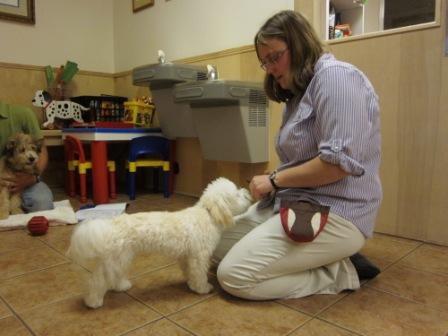Starting your puppy off on the right paw:
1. Handling exercises – for 5-10 minutes every day, spend some time gently handling your puppy and encourage calm behavior. Speak softly and calmly while doing these exercises and gently reward the puppy with small treats like Cheerios for calm, accepting behavior.
A. Practice holding each of your puppy’s feet, playing with its toes, and then releasing the paw only when the puppy is not pulling away.
B. Gently lift both of your puppy’s ears (without pulling) and, with a tissue wrapped around your fingertip, wipe the surface of the puppy’s ear.
C. Lift your puppy’s lips, open its mouth, and brush its teeth with your finger.
D. Hold the puppy in your arms on its back like a baby – this encourages submissive behavior and trust.
2. Feeding exercises – meal time should be a controlled, calm affair.
A. Practice offering the puppy a treat while you move its bowl around, touch the food, and then offer the food from the palm of your hand to encourage the puppy to trust you and to discourage food aggression.
3. House training – house training can be the most rewarding and the most challenging part of puppyhood. Consistency is the most important factor in house training.
A. Never leave the puppy unsupervised in the house. Practice the “umbilical cord” method of house training in which you always keep the puppy in sight by keeping it on a short leash by your side at all times.
B. Always walk the puppy immediately after waking up, eating, drinking, or playing.
C. Praise and give a food reward when the puppy goes to the bathroom outside.
D. Crate training can be enormously helpful to house training.
4. Problem behaviors – start early training your puppy what behaviors are desired and which aren’t. Do not punish the puppy if it is doing an undesirable behavior – instead, redirect the puppy to a behavior you want like telling it to sit or by offering a chew toy.
A. Biting/nipping/chewing: Immediately say “ouch” and pull your hand away if the puppy is biting or nipping you and stop playing with it.
B. Jumping: Do not encourage jumping. Instead, ignore the puppy and turn away when it is jumping, then firmly say “off” and instruct the puppy to sit.
5. Training – start teaching basic commands and manners early.
A. Collar and leash: get an appropriately sized collar and a 6-foot leash (non-retractable). Start by simply allowing your puppy to sniff the collar, then offer the puppy a treat. Repeat this a few times and then offer the puppy a treat that may take a few moments to chew. While the puppy is distracted, gently put the collar on and offer the puppy another treat, then play with the puppy. When the puppy is comfortable with the collar, call the puppy to you and offer a treat, then repeat the process with the leash. Carefully attach the leash and then lure the puppy toward you with a treat and without pulling on the leash. If the puppy will not come, gently pull the leash, release pressure as soon as the puppy takes a step toward you, then offer it the treat and start again. Never chase the puppy to put on the leash, always have the puppy come to you and reward it.
Please refer to your puppy care kit for more detailed information on crate training, bite inhibition, and feeding exercises.




